Joint Light Tactical Vehicle
The Joint Light Tactical Vehicle (JLTV) is a United States military (specifically U.S. Army, USSOCOM, and U.S. Marine Corps) program to part-replace the Humvee[3] with a family of more survivable vehicles with greater payload. Early studies for the JLTV program were approved in 2006.
| Joint Light Tactical Vehicle | |
|---|---|
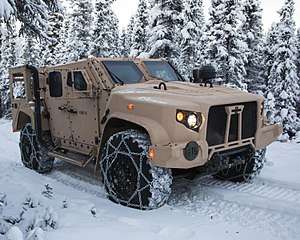 A production standard USMC JLTV in M1280 General Purpose (GP) configuration, this example fitted with a deep fording kit and tire chains | |
| Type | Light tactical vehicle |
| Place of origin | United States |
| Production history | |
| Designer | Oshkosh Corporation |
| Designed | 2005–2015 |
| Manufacturer | Oshkosh Defense |
| Unit cost | US$433,539[1] (inc R&D) (FY15) |
| Produced | 2016 (Low Rate Initial Production, LRIP); 11,216 JLTVs had been ordered by November 2019 |
| Variants | M1278, M1279, M1280, M1281, plus a companion trailer. JLTV-RV (JLTV - Reconnaissance Vehicle) (selected) |
| Specifications | |
| Armor | Classified (A-kit/B-kit configuration) |
Main armament | Various light and medium caliber weapons, plus AGLs or ATGWs if required |
| Engine | Gale Banks Engineering 866T, 6.6-liter diesel (based on GM Duramax architecture)[2] |
| Transmission | Allison 2500SP six-speed automatic |
| Suspension | Oshkosh TAK-4i independent suspension |
Operational range | 300 miles |
| Maximum speed | Forward: 70 mph (110 km/h) Reverse: 8 mph (13 km/h) |
Steering system | Power-assisted, front axle |
The JLTV program incorporates lessons learned from the earlier and now halted Future Tactical Truck Systems (FTTS) program and other associated efforts.[4] The JLTV program has evolved considerably throughout various development phases and milestones including required numbers and pricing. Variants are capable of performing armament carrier, utility, command and control (shelter), ambulance, reconnaissance and a variety of other tactical and logistic support roles. JLTV follows the US Army's Long Term Armor Strategy (LTAS) with kits for two levels of armor protection.
Oshkosh's L-ATV was selected as the winner of the JLTV program in August 2015 and awarded an initial production contract for up to 16,901 JLTVs. The U.S. Army approved the JLTV for full–rate production in June 2019.
History
The High Mobility Multipurpose Wheeled Vehicle (HMMWV), which first entered service in 1985, was developed during the Cold War when improvised explosive devices (IEDs) and asymmetric warfare were not a major factor for military planners. The HMMWVs demonstrated vulnerability to IEDs and the difficulties and costs experienced in satisfactorily up-armoring HMMWVs led to the development of a family of more survivable vehicles with greater payload and mobility. JLTV was originally reported as a one-for-one HMMWV replacement; however, US DOD officials now emphasize that JLTVs are not intended to replace all HMMWVs.[5]
The JLTV publicly emerged in 2006. Early government documents noted: "In response to an operational need and an aging fleet of light tactical wheeled vehicles, the joint services have developed a requirement for a new tactical wheeled vehicle platform that will provide increased force protection, survivability, and improved capacity over the current [Up-armored Humvee] while balancing mobility and transportability requirements with total ownership costs." The joint service nature of the effort was assured through Congressional language in the Fiscal Year 2006 (FY06) Authorization Act, which mandated that any future tactical wheeled vehicle program would be a joint program.[4]
The Joint Chief of Staff's Joint Requirements Oversight Council (JROC) approved the JLTV program in November 2006; this began a 13-month Concept Refinement phase which is a pre-systems acquisition process designed to further develop the initial concepts resident in the Initial Capabilities Document (ICD). The Concept Refinement phase also includes an Analysis of Alternatives (AoA). At the conclusion of the Concept Refinement phase in December 2007, the Joint Program Office (JPO) JLTV Project Manager (PM) intended to transition the program directly into the Engineering, Manufacturing, and Development (EMD) phase. However, as the calendar date for the milestone approached, it became clear that the Milestone Decision Authority (MDA), Defense Acquisition Executive (DAE), John Young, would not support the JLTV program entering into the acquisition process at that time. He denied the request and instructed the Army and the Marine Corps to develop a more vigorous Technology Development (TD) phase.[4]
The US DOD released a Request for Proposal (RFP) for the TD phase of the JLTV program on 5 February 2008. Industry proposals were due no later than 7 April. TD phase contract award was postponed in July 2008.[4]
The following companies and partnerships responded to the TD phase RFP:
- Boeing, Textron and Millenworks[6][7]
- General Dynamics and AM General (as "General Tactical Vehicles")[8]
- Force Protection Inc and DRS Technologies[9][10] (officially rejected on 14 August 2008).[11]
- BAE Systems and Navistar
- Northrop Grumman, Oshkosh Truck and Plasan
- Lockheed Martin, BAE Systems Land & Armaments Global Tactical Systems, Alcoa Defense and JWF Industries.[12][13]
- Blackwater and Raytheon[14]
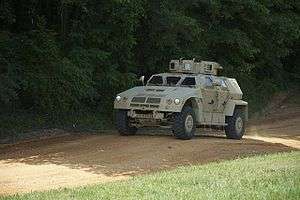
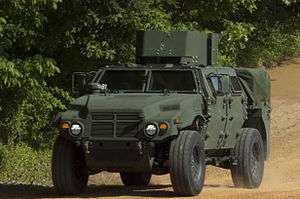
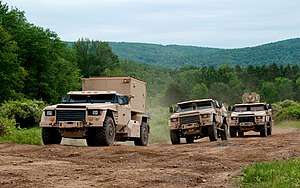
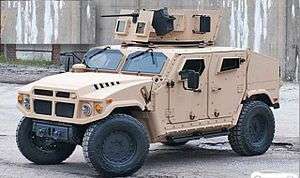
On 28 October 2008, the Pentagon narrowed the field of vendors to Lockheed Martin, General Tactical Vehicles and BAE Systems/Navistar. Each team were awarded contracts worth between $35.9 million and $45 million to begin the next phase of the program, which at the time was stated to be worth $20 billion or more.[15] The Northrop Grumman/Oshkosh group contested the awards but their protest was denied by the Government Accountability Office on 17 February 2009.[16]
Australia signed an agreement in February 2009 to fund nine of the first 30 JLTV prototypes.[17] While a final decision has yet to be made, the Australian Government is now pursuing the Hawkei, a domestically developed vehicle through Thales-Australia.[18] India became interested in the program in 2009,[19] but is currently pursuing an indigenous solution. Israel and the UK have also expressed interest in the program.[4]
On 1 June 2010, it was confirmed that all three contractors had delivered seven JLTV platforms for TD phase evaluation. The U.S. Army appeared to have reduced its support for the program at this time, omitting JLTV numbers from its tactical vehicle strategy published in June 2010.[20][21] However, the U.S. Army clarified that JLTVs are slated to both replace and complement the Humvee.[21][22]
JLTV's TD phase lasted 27 months and in May 2011 it was completed. In February 2011, the JLTV Program Office announced the award of the follow-on Engineering and Manufacturing Development phase contract would be delayed until January or February 2012 because the Army changed requirements for the JLTV, requiring it to have the same level of under body protection as the Mine-Resistant, Ambush-Protected All-Terrain Vehicle (M-ATV).[4]
Upon exiting the TD phase CDD version 3.3 was published. By the time CDD version 3.3 was published, payload options had been reduced to only two. CDD version 3.3 dropped payload verbiage and replaced it with variants. From that point on there were only two required variants; The Combat Tactical Vehicle (CTV) configuration, which would replace the previous Category A and Category B configurations, would be a 4-seat vehicle with a 3,500 pound payload. The Category B variant was eliminated because it proved to be too heavy to meet the required weight of approximately 15,639 pounds to make it transportable by Army CH-47F and Marine Corps CH-53K helicopters. The Combat Support Vehicle (CSV), which would replace the previous Category C configuration, would be a 2-seat vehicle with a 5,100 pound payload. The two variants that appeared in CDD version 3.3 now had requirements for configurations. Configuration refers to the different types of mission packages that will be installed into each of the two variants. CDD version 3.3 required six configurations.[4]
The draft Request for Proposals (RFP) for JLTV's EMD phase was released on 2 October 2011. This called for an average unit manufacturing cost between $230,000 and $270,000 across the JLTV family of vehicles. The cost target for the B-kit armor package remains at US$65,000. EMD phase requirements also created some trade space for industry by easing weight and mobility constraints. At this time JLTV was in danger of severe budget cuts and possible full cancellation in the wake of spiraling costs, delays and defense-wide budgetary cutbacks; it was also competing against the HMMWV Modernized Expanded Capacity Vehicle (MECV) program, the draft RfP for which was released on 11 August 2011. On 26 January 2012 the Request for Proposals for JLTV's EMD phase was released. Budget priorities for FY13 released on the same day included the termination of the HMMWV MECV Recap program in order to focus vehicle modernization resources on JLTV.[4]
Engineering and Manufacturing Development (EMD) phase
Not all of the TD phase contract award teamings remained in place for JLTV's Engineering and Manufacturing Development (EMD) phase. By late March 2012 (bids due 27 March), it was clear that at least six teams had submitted responses to the EMD phase RFP,[23] and following EMD phase contract awards on 23 August 2012, in September Hardwire LLC disclosed itself as a previously unknown seventh bidder. The bidders were:
- AM General (still at the time teamed with GTV for a separate offering) offered the Blast-Resistant Vehicle – Off Road (BRV-O), a product based on its own R&D, and a design that leveraged some of AM General's then recent experience with HMMWV MECV designs.
- BAE Systems (previously teamed with Navistar) realigned its team for the EMD phase to include Ford (Ford Motor Company's Power Stroke 6.7 liter turbocharged diesel engine; Ford had been considering participating in the JLTV's EMD competition with its own offering) and proposed a design that capitalized on earlier TD phase work with the Valanx.
- GTV dropped its TD phase developed design and opted to offer a lowest risk solution, a further development of the in-production MOWAG Eagle.
- Lockheed Martin opted to stay with its TD phase offering, albeit a version that according to the company was "hundreds of pounds lighter in weight."
- Navistar, which broke away from BAE Systems for the EMD phase, offered a variant of its Saratoga light tactical vehicle, this unveiled in October 2011 as a middle-ground offering between the HMMWV and JLTV, the latter with its then current TD phase spec still technically in place.
- Oshkosh proposed a variant of the company's L-ATV, unveiled in October 2011. L-ATV has developmental origins that trace back to Oshkosh/Northrop-Grumman's failed initial JLTV proposal.
- Hardwire offered a proposal featuring a hybrid-electric drive train. Hardwire's armor has been employed on MRAP vehicles, and the company is known for developing a "blast chimney" that it designed to provide an outlet for energy released in an underbelly blast.[4]
On 23 August 2012, the Army and Marine Corps selected the Lockheed Martin JLTV, the Oshkosh L-ATV, and the AM General BRV-O as the winners of the Engineering and Manufacturing Development (EMD) phase of the competition. The three companies were awarded a contract to build 22 prototype vehicles in 27 months to be judged by the services.[24] Losing bidder Navistar filed a protest with the Government Accountability Office (GAO) over the evaluation criteria on 31 August 2012;[25] the company withdrew the protest on 4 September 2012.[26]
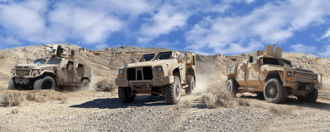
On 26 June 2013, Lockheed Martin completed the last of 22 JLTVs produced for the EMD phase.[27] On 8 August 2013, Oshkosh delivered its first L-ATV JLTV prototype to the Army for government testing following a successful vehicle inspection by the Defense Contract Management Agency (DCMA). The four-door multi-purpose variant and two-door utility variant were provided for evaluations.[28] On 14 August 2013, both AM General and Lockheed delivered their 22 vehicles to the Army and Marine Corps to participate in a 14-month government evaluation and testing process.[29][30]
On 27 August 2013, the Army and Marine Corps announced that full-scale testing of JLTV prototypes would begin the following week, with all three vendors having had 66 vehicles delivered. Each company delivered 22 vehicles and six trailers to Aberdeen Proving Ground, Maryland, and Yuma Proving Ground, Arizona. Previous testing had already put the vehicles through more than 400 ballistic and blast tests on armor testing samples, underbody blast testing, and more than 1,000 miles in shakedown testing. Soldiers from the Army Test and Evaluation Command and personnel from the Defense Department's Office of Test and Evaluation would put the vehicles through realistic and rigorous field testing during 14 months of government performance testing. Testing was to be completed by FY 2015, with a production contract to be awarded to a single vendor for nearly 55,000 vehicles.[31] On 3 September 2013, full-pace, full-scope JLTV testing began at Aberdeen Proving Ground, Yuma Proving Ground, and Redstone Arsenal, Alabama.[32]
Testing of the JLTV was temporarily halted in early October during the two-week U.S. Government shutdown of 2013. Civilian workers were furloughed and test sites were closed within hours. Work restarted immediately when the shutdown ended, though one site remained closed until 22 October. The Army and Marine Corps have vowed commitment to buying nearly 55,000 JLTVs even in the face of sequestration cuts. This level of support was given while major acquisition programs like the Ground Combat Vehicle were in danger of cuts (and eventually cancelled), which potentially meant the Army was favoring replacing Humvees more than the M2 Bradley. Army leaders worried that the Marines' priority with the Amphibious Combat Vehicle program could cause them to back out of JLTV procurement. However, the Marines said procurement plans for the two efforts did not overlap and should not conflict with each other.[33][34]
On 1 October 2013, the Defense Department Inspector General launched a year-long audit of the Joint Light Tactical Vehicle program. It was one of about a dozen acquisition programs outlined in the IG's FY 2014 "audit plan". The audit was to determine whether Army and Marine officials were overseeing and managing the program effectively before low-rate production begins. A June 2013 report by the Congressional Research Service estimated the program cost at $23 billion, or $400,000 per vehicle; military leaders contended the unit cost is to be $250,000.[35] The Army planned to issue a request for proposals to companies interested in bidding for production contracts in mid-November 2014, and to pick a winner possibly by July 2015.[36] Discrepancies in unit cost have been attributed to different methods for analyzing cost. The Pentagon IG report concluded program officials "appropriately assessed the affordability" of the effort, and that average unit production cost remains stable at $250,000.[37] All three vehicles completed Limited User Testing (LUT) and Production Readiness Reviews (PRRs) by mid-November 2014.[38]
Final selection
The Army released the final JLTV RFP for low rate initial production (LRIP) and full rate production (FRP) on 12 December 2014, clearing the way for AM General, Lockheed Martin, and Oshkosh Defense to submit their vehicle proposals. The Army gave competitors until 10 February 2015, to refine and submit their bids. The Army, on behalf of itself and the Marines, stated plans to select a winner and issue a single contract award in the late summer of 2015.[39] The winning contractor would build approximately 17,000 JLTVs for the Army and Marines during three years of LRIP, followed by five years of FRP. The first Army unit would be equipped with JLTVs in FY 2018, and the Army's complete acquisition of 49,099 JLTVs would be completed in 2040, with 2,200 JLTVs delivered each year between 2020–36. The Marines would begin acquiring their then required 5,500 JLTVs at the beginning of production and would be completed by FY 2022.[39]
FY 2015 budget requests included US$164.6 million (RDT&E US$45.7 million) for 176 JLTV (Army), and US$7.5 million (RDT&E US$11.5 million) for seven (USMC) JLTV in various configurations. The total procurement cost of the JLTV program was quoted as US$30.04 billion (official DoD FY2015 estimate) + US$0.98 billion in research and development (RDT&E) funds, giving a total estimated program cost of US$31.03 billion (figures are aggregated annual funds spent over the life of the program with no price/inflation adjustment). The GAO estimated that the DoD will allocate about US$53.5 billion for the JLTV program, split US$1.082 billion for RDT&E and at least US$52.298 billion for procurement.[39] By April 2015 TACOM had rescheduled JLTV's Milestone C decision for August 2015. The Army and Marines still expected LRIP to commence in FY2015, with TACOM expecting JLTV to enter full-rate production by FY2018. The Army expected JLTV to achieve Initial Operational Capability in 2019.[39]
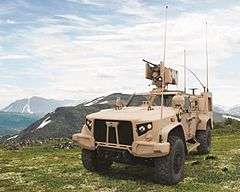
Oshkosh was selected on 25 August 2015.[40] The award includes a base contract and eight option years covering three years of LRIP and five years of FRP. The initial contract award is valued at US$114 million and is for two year LRIP. LRIP was slated to begin in the first quarter of FY 2016, with Oshkosh commencing delivery of vehicles approximately 10 months after contract award. A FRP decision was expected in FY 2018, with associated production commencing in November or December 2019.[41] A FRP decision is now expected in FY 2019. The JLTV contract award has a value of up to US$6.749 billion and calls for a maximum of 16,901 JLTVs, and includes a sustainment element. JLTV manufacturing will be performed in Oshkosh, WI. Oshkosh CEO, Charles Szews, said the production contract award would involve more than 300 suppliers in 31 states across the country. The Army initially refused to detail why the L-ATV was chosen over its competitors, likely owing to anticipations of protests from either or both of the losing bidders, these to be submitted within ten days of contract award.[42][43]
On 8 September 2015, it was reported that Lockheed Martin would protest the award; on the same day it was also disclosed that AM General had decided not to file a protest. Any work that would be performed under the contract stopped during the review period.[44] On 15 December 2015 the Government Accountability Office GAO dismissed Lockheed Martin's protest because the company on 11 December 2015 decided to file a “Notice of Post-Award Bid Protest” with the U.S. Court of Federal Claims; according to a source with knowledge of the procedures, it is uncommon for a company to file with the court close to a GAO protest decision.[45][46] Immediately after the GAO dismissed the protest, the Army instructed Oshkosh to resume work on the JLTV order.[47] Lockheed Martin filed a preliminary injunction on 17 December, stating that new Army-supplied information related to the contract emerged toward the end of the GAO's protest process that was not considered before their ruling and no deadline extension was granted.[48] The U.S. Court of Federal Claims denied Lockheed Martin's request to stop work while the lawsuit was pending, allowing Oshkosh to continue work during the process.[49] The company withdrew its protest in the Court of Federal Claims on 17 February 2016.[50][50]
Around the time Lockheed Martin withdrew its protest some potentially crucial data from JLTV testing was revealed. The 472–page annual report from the Pentagon's independent Director of Operational Test & Evaluation revealed that in testing Oshkosh's JLTV prototype lasted nearly six times longer between significant breakdown than the next closest, Lockheed Martin's prototype. The Oshkosh vehicle achieved 7,051 Mean Miles Between Operational Mission Failure (MMBOMF), Lockheed Martin's vehicle achieving 1,271 MMBOMF. AM General's vehicle achieved just 526 MMBOMF. The target for JLTV is 2400 MMBOMF, the current up-armored HMMWV achieving 2,968 MMBOMF.[51][52] Information on protection levels was also released. It was found in testing that both Oshkosh and Lockheed prototypes met all threshold force protection requirements and some objective-level requirements. This level of protection is better than that of up-armored HMMWVs, and similar to MRAP (Mine Resistant Ambush Protected) All-Terrain Vehicles (M-ATV) without the underbody improvement kit across all spectrum of tested threats. AM General's prototype would need a significant redesign to meet threshold protection requirements. More details on vehicle protection were included in a classified report.[53]
In the Pentagon's FY 2017 budget, it requested US$587.5 million to procure 1,828 JLTVs for the Army and US$113.2 million to procure 192 for the Marines. About US$34.7 million was requested for research and development between the Army and Marines' JLTV programs.[54] Procurement objectives at this time remained 49,099 JLTV for the Army and 5,500 for the Marines.[55]
The first delivery order for JLTV was announced on 23 March 2016 with the U.S. Army ordering 657 JLTVs, along with kits and support. The $243 million order included vehicles for the Army and Marines. According to Oshkosh, "The vehicles, trailers, and installed kits for this order will be delivered by first quarter FY2018."[56][43] As part of the original JLTV LRIP/FRP Base Award in August 2015, an initial 201 JLTVs for the test and evaluation phase were ordered. The 657-vehicle order is an exercised option from the program's eight option years.[57] In April 2016 it was disclosed that JLTV's Initial Operating Capability (IOC) for both services would be delayed as a result of earlier protests and associated issues. Initial USMC operating capability was stated to be delayed by about one year to the first quarter of fiscal 2020, with 69 JLTVs for a Marine infantry battalion, with procurement by the Marines complete by FY 2022. The Army anticipated a six-month delay, reaching IOC in mid-2019. Army procurement will last until approximately 2040.[58]
According to the Pentagon's 2016 Selected Acquisition Report (SAR), released on 24 March 2016, The JLTV program has dropped its total costs by $5.9 billion. JLTV's total program costs dropped 19.32%, from $30.574 billion to $24.668 billion "due primarily to revised estimates for unit costs of vehicles and kits based on realized savings", which accounted for a $3.7 billion decrease. A stretched out procurement "due to budget adjustments and revised assumptions regarding the maximum buy profile year" decreased costs by $1.28 billion, and several other changes – such as for cost estimation methodologies and indices – accounted for another $921 million decrease.[59] The SAR's total cost estimates include "research and development, procurement, military construction, and acquisition-related operations and maintenance" associated with a program, the Pentagon said. These reflect actual costs so far and anticipated costs in the future, with all estimates in fully inflated then-year dollars.[59]
On 11 May 2016, the U.S. Army disclosed that the JLTV is to be used as the platform for the upcoming Light Reconnaissance Vehicle (LRV) program rather than procuring a new system. The LRV is to be an off-road platform for carrying a suite of intelligence, surveillance, and reconnaissance sensors; it is to be light enough to be carried by a CH-47 Chinook helicopter. The JLTV has been described as an "interim LRV solution", and there is a possibility that evaluation of JLTV in the LRV role will determine if a change is necessary.[60]
On 26 September 2016, the U.S. Army placed an order for another 130 JLTVs and 748 kits valued at $42 million; this was the third JLTV order since contract award. Fiscal Year 2016 funding budgets for 804 JLTVs.[61] The Army received its first seven JLTVs for test at the end of September 2016 according to Colonel Shane Fullmer, JLTV project manager stated at an AUSA 2016 media briefing. He said test vehicles would be sent to Yuma, Arizona, for automotive and mobility testing; to Ft Huachuca, Arizona, for cyber, electronic warfare, and C4 testing; Aberdeen Proving Ground, Maryland, for reliability and automotive testing; and to Alaska for automotive and environmental testing. Some JLTV testing was deferred during the EMD phase, as the government did not want to pay for testing with three suppliers, and it is now set for testing with a fleet of 100 JLTVs. By April 2017 30 JLTVs had been delivered, testing expected to continue through the first quarter of FY19.[41] Also at an AUSA 2016 media briefing, Scott Davis, program executive officer for Combat Support & Combat Service Support, stated that Overall the JLTV program expects to cut about five years off of the total program and save about US$5.9 billion, as Oshkosh's final competitive bid was low enough so the Army decided to 'buy to budget' and get more platforms each year, which shrunk the total length of the contract and increased cost avoidances accrued each year.[62] At AUSA 2016, Oshkosh displayed a JLTV General Purpose variant equipped with an EOS R-400S-MK2 remote weapon system integrated with Orbital ATK's M230 LF 30 mm lightweight automatic chain gun.[63]
The fourth JLTV order was announced on 2 January 2017, this for 409 vehicles, 1,984 installed kits, 82 packaged kits, as well as related services and support. The order is valued at an estimated $179 million and deliveries will begin late 2017.[64] On 4 January 2017 it was reported the U.S. Air Force was considering acquiring JLTVs for its security forces that protect missile launch facilities.[65]
In its 2018 budget the Pentagon requested $1.143 billion for the JLTV program. For procurement, the DoD requested $1.099 billion split $804.4 million for 2,110 Army JLTVs, $60.5 for 140 Air Force JLTVs, and $233.6 for 527 Marines' JLTVs. The Army and Marines also requested $44.2 million for research, development, test, and evaluation.[66]
In May 2017, it was reported that the JLTV-RV (JLTV - Reconnaissance Vehicle) is to be incorporated into the current JLTV Technical Data Package (TDP) and will be a kit option on the next JLTV contract. The JLTV-RV is designated as the interim solution for the LRV requirement.[67]
In June 2017, the first US soldiers to receive JLTVs was revealed. According to the Army its first unit to receive JLTVs was to be an Infantry Brigade Combat Team (IBCT) in the 10th Mountain Division at Fort Drum. The bulk of their 500 HMMWVs were to be replaced by early 2019. The 173rd Airborne Brigade Combat Team in Vicenza, Italy, were to be next and then a brigade in Hawaii (probably with the 25th Infantry Division). According to the Marines, a yet-to-be-identified infantry battalion within II MEF at Camp Lejeune, North Carolina, will receive 69 JLTVs to replace the same number of Humvees in July 2019. Within 90 days, a similar unit with I MEF will receive JLTVs, and within another nine months, a unit with III MEF in Japan will follow.[68] Also in June 2017 the Marines revealed they wished to adjust their acquisition objective for JLTV by 65% to up to 9,091 vehicles. At this time overall JLTV requirements remained at 5,500 for the USMC and 49,099 for the army.[69]
On 1 August 2017, Oshkosh announced the fifth JLTV order, this for 748 vehicles and 2,359 installed and packaged kits. The order is valued at more than $195 million and is scheduled for completion by November 2018. Oshkosh also confirmed the JLTV remains on-schedule and on-budget.[70] Also in August, further details of the 140 JLTVs requested by the Air Force in FY 2018 appeared. This initial request is understood to require 46 Utility variants, 48 GP variants, and 46 Heavy Gun Carrier variants. Fielding is scheduled for FY 2019, with vehicles to be used by security forces, explosive ordnance disposal teams, para-rescue and personnel recovery units, tactical air control party teams, and special tactics forces. At this time, released documents revealed no further planned JLTV procurement for the period FY 2019-22, but the service was known to want to replace its entire fleet of 3,270 HMMWVs with JLTVs.[71]
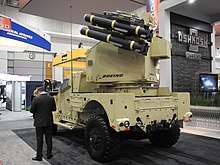
On 1 September 2017, Oshkosh announced the sixth JLTV order, this valued at more than $177 million and including 611 vehicles and 1,789 installed and packaged kits.[71]
At AUSA 2017 JLTVs were displayed in three new configurations. Oshkosh displayed a General Purpose variant fitted with a Boeing Compact Laser Weapon System (CLWS), a Kongsberg Protector LW 30 Remote Weapon System (RWS) with a M230LF cannon, and a communications suite that includes a Thales VRC-111 and Thales VRC-121 VIPER. The company also displayed a Utility variant equipped with the Boeing Maneuver Short Range Air Defense (SHORAD) Launcher including a M3P .50 cal machine gun, M299 launcher with four Longbow Hellfire missiles, sensor suite, and a communications suite including a Thales VRC-111. Rafael displayed a General Purpose vehicle fitted with the company's Samson RWS Dual Stabilized Remote Weapon Systems (RWS) with M230 LF, and the Trophy Light Active Protection System (APS).[72]
On 21 December 2017, Oshkosh announced the seventh JLTV order, this valued at $100.1 million and including 258 vehicles and associated installed and packaged kits. At this time it was also announced that to date over 1,000 JLTVs had been delivered.[73] On 5 February 2018, Oshkosh announced the eighth JLTV order, this valued at $106 million and including 416 vehicles and associated installed and packaged kits.[74] On 29 June 2018, Oshkosh announced the ninth JLTV order, this valued at $484 million and including 1,574 vehicles and associated installed and packaged kits.[75] On 28 November 2018, Oshkosh announced the tenth and most recent US JLTV order, this valued at $1.69 billion and including 6,107 vehicles and associated installed and packaged kits.[76] This tenth order brought the total of JLTVs ordered for US forces to date to 11,111.
US budgetary documentation released in early 2018 revealed that inclusive of FY 2019 budget announcements the U.S. Air Force has now requested a total of 230 JLTVs. Also in early 2018 the Marines 2018 Planning Objective for JLTV was disclosed to be 9,091, although funding (as of April 2018) allowed for only 7,622 JLTVs through FY 2023, with deliveries concluding the first quarter of FY 2025. The Marines also have a requirement for 318 JLTV trailers by 2022.[77]
For FY 2020 (1 October 2019-30 September 2020) the Pentagon’s JLTV funding request totals US$1.641 billion, this to procure 2,530 vehicles for the Army, 1,398 for the Marines (with 3,986 more between FY2021 and FY2024), 140 for the Air Force, and 22 for the Navy. Other FY 2020 budget activities include US$4.8 million for engineering and manufacturing development. In March 2019 it was reported that Army’s FY2020 budget request included proposed cuts to pay for modernisation priorities, with one of those proposed cuts being the JLTV. It was reported that over the coming five years the service will spend US$800 million less on the JLTV programme than initially expected, this potentially resulting in the purchase of 1,900 fewer vehicles. As of May 2019 the service had not changed its approved acquisition objective (AAO) of 49,099 JLTVs.[78]
Fielding and deployment
_(49044642738).jpg)
Following an announcement in December 2018 that a total of 500 JLTVs would be delivered by the end of March 2019, JLTV deliveries to the Army commenced the week of 7 January 2019. The first unit to receive JLTVs was the 1st Armored Brigade Combat Team, 3rd Infantry Division at Fort Stewart. To coincide with the first fielding Oshkosh confirmed that over 3,000 JLTVs had been delivered to the Army and Marine Corps.[79]
The Marines announced on 28 January 2019 that its first JLTV had fielded that day at the School of Infantry West at Camp Pendleton, California. By the end of May the Marines will have fielded its first 55 vehicles to support units at training locations including the School of Infantry West, School of Infantry East and the Motor Transport Maintenance Instructional Company. The first JLTVs for operations will go to 3rd Battalion, 8th Marines in Camp Lejeune, NC, and once that fielding takes place in July the Marine Corps will be able to declare Initial Operational Capability (IOC) for the JLTV. By the end of fiscal year 2019 when between 250 and 300 JLTVs will be delivered, all three Marine Expeditionary Forces – I MEF in Camp Pendleton, II MEF in Camp Lejeune and III MEF in Okinawa, Japan, will have received some combination of JLTVs. Around 1,000 Further JLTVs are scheduled to be fielded during Fiscal Year 2020.[80]
Also in January 2019, the Army Reserve announced it was set to acquire 60 JLTVs for training in preparation for fielding to the entire force. No date for actual fielding was given.[78]
On 20 June 2019, Dr. Bruce Jette, Assistant Secretary of the Army for Acquisition, Logistics and Technology, approved the JLTV program's transition into full–rate production (FRP).[81]
The Marine Corps declared initial operation capability for the JLTV on 2 August 2019, ahead of the scheduled June 2020 date.[82]
Foreign Interest
UK MoD interest

In June 2016 it was reported that to meet Package 1 of the Multi Role Vehicle-Protected (MRV-P) requirement, the UK Ministry of Defence (MoD) was in talks with the Pentagon on acquiring the JLTV via the Foreign Military Sales (FMS) route. “We can confirm that we are talking to the US DOD regarding Package 1 [of MRV-P], to inform our understanding of an FMS option for the Joint Light Tactical Vehicle,” said an MoD spokesman.[83] It was stated in January 2017 by Maj. Gen. Robert Talbot Rice, the director of land equipment at the Defence Equipment and Support arm of the Ministry of Defence (MoD), that: "We are working through the Foreign Military Sales process. A letter of request has been sent to our American colleagues, and we expect a response in the next few months." Talbot Rice told an audience of industry executives and military personnel at the International Armoured Vehicles conference in London on 24 January that the Army had opted for the single-source purchase due to its ability to meet UK requirements and its value for money.[84]
In July 2017, the DSCA notified US Congress of a possible sale of 2,747 JLTV vehicles and accessories to the UK.[85] At DSEi 2017 in London Oshkosh displayed a JLTV in British Army green and fitted with UK-specific equipment.[71]
Lithuanian order
In November 2017, Defense News reported that the Lithuanian Ministry of National Defence (MND) had contacted the U.S. Department of Defense about a potential acquisition of 200 JLTVs. Deliveries were planned to begin in 2021.[86] In February 2019, the Ministry of National Defence submitted a procurement application to the U.S. Government. Terms and conditions were expected to be finalized by 2020.[87]
On 27 August 2019, the U.S. State Department approved a possible Foreign Military Sale to Lithuania of up to 500 JLTVs and support for an estimated cost of $170.8 million. That same day the Defense Security Cooperation Agency notified Congress of this possible sale.[88] The disparity between the Lithuanian MoD and DSCA totals was explained that Lithuania may buy more than its planned buy of 200 JLTVs. In 2019, the Lithuanian MoD expected the contract negotiations would be completed in 2019.[89] On 21 November 2019, Lithuania and the U.S. State signed contract for 200 JLTVs.[90]
Slovenian order
Slovenian Defence Minister Karl Erjavec disclosed on 14 November that Slovenia had signed a government-to-government agreement with the US on the procurement of 38 JLTVs for the army's medium-sized battlegroup. Deliveries are to run from 2021 to 2023. This was the first confirmed Foreign Military Sale of the JLTV and increased the JLTV order total to 11,149 as of November 2018.[91]
Montenegrin order
Montenegro signed a US$36.17 million contract for the procurement of 67 JLTVs, the Montenegrin announced on 23 October 2019. The vehicles will equip Montenegro’s NATO-declared forces: the 1st Infantry Company in Nikšić and the 2nd Infantry Company in Pljevlja. The first 20 vehicles are scheduled to arrive in 2020, making Montenegro Europe's first JLTV operator. Montenegro is to acquire 55 JLTVs in basic configuration, eight in anti-tank configuration, and the remaining four in medical and command configurations. It is likely they will be upgraded later with Israeli combat systems.[92]
Technical description
Given the competitive nature of the JLTV competition, only limited technical detail has been released by either the US Army or Oshkosh. No specific dimensions and only limited operating weight and automotive data is available.[78]
The JLTV is based around Oshkosh's TAK-4i (i=intelligent) independent suspension system. Around 26,000 military vehicles are fitted with an earlier version of the system,[93] these including the Oshkosh Medium Tactical Vehicle Replacement (MTVR), Oshkosh Logistic Vehicle System Replacement (LVSR), and Oshkosh MRAP All-Terrain Vehicle (M-ATV); the TAK-4 system has also been retro-fitted to the Force Protection Inc Cougar and BAE Systems RG-33 MRAPs.[94] The majority of systems supplied to date have been coil-sprung. The TAK-4i version fitted to the JLTV remains undisclosed, but is not coil-sprung and is of the variable adjustable ride-height type with up to 20 inches (51 cm) of wheel travel, 25 percent more than the current standard.[95][96] The JLTVs Suspension Aided Egress System (SAES) capability levels side to side and front to rear on slopes or grades when selected by the operator. The front and rear suspension height can also be independently controlled for ship and transportability. The suspension system has ride height control at all four wheels.[78]
Motive power is provided by a digitally-controlled Gale Banks Engineering 866T V-8 diesel, this based on the architecture of the General Motors (GM) Duramax LML.[2] Power output is 340 hp. In commercial use power output of the standard Duramax LML engine is currently up to 397 hp (296 kW) at 3,000 rpm. Production of the Duramax LML engine concluded in 2017, the unit replaced by the Duramax LP5. JLTV A1 models that were introduced in 2017 are powered by a derivation of this engine. An Allison 2500SP six-speed fully automatic transmission is fitted.[78]
The JLTV has been designed to comply with the U.S. Army's Long Term Armor Strategy (LTAS). The LTAS system follows an A-kit/B-kit principle, with vehicles designed 'fitted for, but not with', protection. Protection kits can be installed and uninstalled from vehicles in the field using only basic tools. The A-kit is fitted on the production line and is a combination of a limited amount of armoring, in difficult-to-access areas of the vehicle, together with a significant amount of armor installation attachments and required support structures. The bulk of the armor, the B-kit, is installed in the field on an 'as required' basis.[4] Two soldiers can install B-kit armor in five hours. An 800-pound RPG protection kit can be installed in two hours at field-level maintenance and completed by the crew within 30 minutes.[97] The JLTV offers protection levels greater than those of up-armored HMMWVs and comparable to those of original MRAP class designs, but in an overall vehicle package that is considerably smaller and lighter than vehicles procured under the US Marines MRAP procurement.[98]
The benefits of the A-kit/B-kit principle are that armor is only fitted when required, reducing vehicle wear and tear and, by default, whole lifecycle costs. Improvements and/or upgrades to armor are also far easier to integrate into an appliqué solution. No quantity for JLTV armoring kits has yet been disclosed, but it is anticipated that the estimated $65,000 kits will be procured on a 'one kit to three vehicle' basis.[4] The overall protection will include a spall liner to minimize perforation effects within a vehicle when the vehicle takes hostile fire.[99][100]
The JLTV also has an automatic fire-extinguishing system to protect the crew cabin.[97] Fuel tanks are mounted externally and shielded by the JLTV structure. Each crew seat has a combined seat and blast restraint device. Ingress time for a crew of four in combat equipment is 30 seconds or less. Egress with B-kit doors is within 10 seconds.[97]
The only weight-related data officially released includes a gross vehicle weight (GVW) of 10,266 kg. Payload for the two-door variant is quoted as 2,318 kg, payload for the four-door variant is quoted as 1,590 kg. The USMC required a vehicle that can be transported by their current and planned systems. In April 2009, Marine Corps Commandant Gen. James Conway warned that the Marines "will not buy a vehicle that's 20,000 lb."[101]
Requirements called for the cabin heater to raise the crew compartment temperature from −40 °F (−40 °C) to 65 °F (18 °C) in one hour. The air-conditioner should drop the temperature from 120 °F (49 °C) to 90 °F (32 °C) within forty minutes.[97] The JLTV was to be equipped with a diagnostic monitoring system that will electronically alert the operator of equipment failures so that they can be fixed. The electronic monitoring will observe the fuel, air intake, engine, cooling, transmission, energy storage, power generation and vehicle speed as well as other systems.[99]
Mobility
The Pentagon required at least 600 mean miles before an essential function failure.[97] The vehicle was to be capable of traveling for 3 miles (5 km) cross-country having endured three 0.3-inch perforations of half-full main fuel tanks.[78][99] The JLTV must also operate in altitudes from minus 500 feet to 12,000 feet and maintain full mission capability in temperatures from −40 to 125 °F (−40 to 52 °C), according to established requirements. When temperatures drop well below zero, the JLTV must start within one minute with no external aids, kits or prior warming of the batteries. The vehicle must be capable of traveling 350 paved miles at 35 miles per hour (56 km/h) or 300 miles (480 km) in operational terrain on a single tank of JP-8 fuel. Acceleration from 0 to 30 miles per hour (0 to 48 km/h) in 9.7 seconds on dry, level, hard terrain was required as a threshold requirement (objective being 7 seconds), as was the ability to ford 60 inches (150 cm) of saltwater without a fording kit, in forward and reverse, while maintaining contact with the ground.[97][78]
Other tactically driven mobility requirements include a threshold 27-foot turning radius and the ability to climb 24-inch vertical obstacles in forward and reverse. JLTV must be able to drive off an 18-inch vertical step at 15 mph and sustain no mechanical damage. It will be capable of traversing a 20-degree V-ditch that is 25 feet wide at an approach angle of 45 degree. It can 'jump' a 6-inch parallel curb at 15 mph and traverse a 20-foot flight of stairs at 5 mph. It must climb a 60 percent dry, hard-surfaced gradient and traverse a 40 percent sideslope with no degradation in driver control.[97][78]
JLTV is transportable by sea, rail, and air. The JLTV is transportable on all classes of ocean-going transport ships with minimal disassembly. It was required to be rail-transportable on CONUS and NATO country railways. Air transportability will be by fixed-wing aircraft as large or larger than the C-130 Hercules and sling-loadable with rotary-wing aircraft such as the CH-47/MH-47 and CH-53. The proposed ambulance variant was to be air-droppable by C-5 and C-17 fixed-wing aircraft.[102] The JLTV can be prepared in 30 minutes for transport by aircraft, Maritime Prepositioning Force ships or rail. This is aided by an adjustable-height suspension.[97][78]
Versions
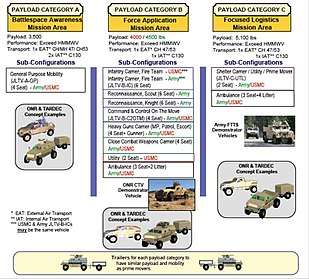
The JLTV family and its nomenclature evolved throughout the development process and to date the U.S. Army has allocated M designations to four individual JLTV configurations.[103]
In JLTV's Initial Capability Document (ICD) there were four payload options, this later reduced to three, Payload Categories A, B, and C. All were to be transportable externally by CH-47 and CH-53 helicopters and internally by C-130 aircraft.[104]
Payload Category A
Payload Category A vehicles were to fill the role of "Battlespace Awareness" with a payload capacity of 3,500 lb (1,600 kg).[104]
General Purpose Mobility: General Purpose Mobility (JLTV-A-GP) was the only variant in Payload Category A, designed for general purpose utility vehicle for use by the Army and Marine Corps, with a four-person capacity.[104] Unlike other variants, a C-130 would be capable of transporting two vehicles at a time.[104]
Payload Category B
Payload Category B vehicles was to fill the role of "Force Application" with a payload capacity of 4,000–4,500 lb (1,800–2,000 kg).[104]
- Infantry Carrier: The Infantry Carrier (JLTV-B-IC) had a 6-person capacity, and was designed to carry a fire-team of troops. Each service may have received a different vehicle, or have used the same configuration.[104]
- Reconnaissance, scout: Six-seat configuration for use by the U.S. Army.[104]
- Reconnaissance, knight: Six-seat configuration for use by the U.S. Army.[104]
- Command and Control on the Move: Four-seat command and control (JLTV-B-C2OTM) configuration for use by the U.S. Army.[104]
- Heavy Guns Carrier: Heavy Guns Carrier for use by the U.S. Army and Marine Corps for convoy escort, military police, and patrol with four seats and a gunner position.[104]
- Close combat weapons carrier: Four-seat close-combat weapons carrier for use by the U.S. Army and Marine Corps.[104]
- Utility vehicle: Two-seat utility vehicle for use by the USMC.[104]
- Ambulance: Ambulance configuration for use by the U.S. Army and Marine Corps. Three seats and two litters.[104]
Payload Category C
Payload Category C vehicles were to fill the role of "Focused Logistics" with a payload of 5,100 lb (2,300 kg).[104]
- Shelter carrier/utility/prime mover: Two-seat shelter carrier/utility/prime mover for use by the U.S. Army and Marine Corps.[104]
- Ambulance: Higher capacity ambulance configuration for use by the U.S. Army and Marine Corps. Three seats and four litters.[104]
By the time Capability Development Document (CDD) version 3.3 was published at the conclusion of JLTV's Technology Development (TD) phase, payload options had been reduced to only two and payload verbiage had been dropped, this replaced by reference to variants. From that point on two stated variants were required, the Combat Tactical Vehicle (CTV) and Combat Support Vehicle (CSV).[105]
The previous Category B variant was eliminated because it proved to be too heavy to meet the required weight of approximately 15,639 lb to make it transportable by Army CH-47F and Marine Corps CH-53K heavy-lift helicopters.[106]
The Combat Tactical Vehicle (CTV) configuration replaced the previous Category A and Category B configurations and was a 4-seat vehicle with a 3,500-pound payload. The Combat Support Vehicle (CSV) replaced the previous Category C configuration and was a 2-seat vehicle with a 5,100-pound payload. The CTV and CSV variants that appeared in CDD version 3.3 had requirements for configurations. Configuration refers to the different types of mission packages that would be installed into each of the two variants. CDD version 3.3 required six configurations. CDD version 3.6 was published for entry into the EMD phase in August, this reducing from six to four the total number of to configurations required.[4]
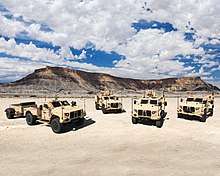
The JLTV family now consists of three base vehicle platforms, Utility (JLTV-UTL), Close Combat Weapons Carrier (JLTV-CCWC) and General Purpose (JLTV-GP). The Utility base vehicle platform is a two-door configuration, the General Purpose and Close Combat Weapons Carrier base vehicle platforms are a four-door configuration. Standard U.S. military M-designators are applied base vehicle platforms when outfitted to a specific Mission Package Configuration. These currently are:
- M1278 Heavy Guns Carrier - General Purpose (JLTV-GP) base vehicle platform in Heavy Guns Carrier Mission Package Configuration
- M1279 Utility - Utility (JLTV-UTL) base vehicle platform in Utility Mission Package Configuration
- M1280 General Purpose - General Purpose (JLTV-GP) base vehicle platform in General Purpose Mission Package Configuration
- M1281 Close Combat Weapons Carrier - Close Combat Weapons Carrier (JLTV-CCWC) base vehicle platform in Close Combat Weapons Carrier Mission Package Configuration
There is also a companion trailer (JLTV-T), this towable by all JLTV variants.[103]
L-ATV specific versions
Oshkosh showcased for the first time the L-ATV Ambulance at the Association of the United States Army (AUSA) Global Force Symposium in Huntsville, AL, from March 26–28, 2019. The L-ATV Ambulance is based on the Utility configuration base platform and the rear can hold 4 litters or up to 8 seated patients or a combination of the two. At present the L-ATV Ambulance is not a JLTV variant but according to the company the design will be marketed to the US Army and Marines.[107]
Operators
Current operators

Future operators



Potential operators


See also
- Future Tactical Truck Systems
- Thales Hawkei – winning bid in 2011 for the Australian Army's tactical vehicle program, beating out JLTV designs and other offerings.
- Combat Tactical Vehicle (Technology Demonstrator)
References
- "GAO-15-342SP DEFENSE ACQUISITIONS Assessments of Selected Weapon Programs" (PDF). US Government Accountability Office. March 2015. p. 97. Retrieved 15 July 2015.
- ""Humvee" Replacement Powered by Banks-Built Duramax Diesel". trucktrend.com. August 2015. Retrieved 11 July 2017.
- "Joint Light Tactical Vehicle (JLTV) Programme". Army Technology.
- "Executive Overview: Logistics Support and Unmanned". IHS Jane's Shaun C Connors & Christopher F Foss. 5 May 2015. Retrieved 19 May 2015.
- Andrew Feickert. "Joint Light Tactical Vehicle (JLTV): Background and Issues for Congress" (PDF). Congressional Research Service. Retrieved 19 March 2015.
- "Defense Markets Summary October 2007 – from www.Defense-Update.com". Archived from the original on 26 October 2007. Retrieved 1 November 2007.
- A Little LUV for the Future Military Jeep Archived 15 October 2007 at the Wayback Machine. Defense Tech
- AM General and General Dynamics Announce Joint Venture Company. globalsecurity.org
- Melissa Davis. "Weak MRAP Order Wrecks Force Protection". TheStreet. Archived from the original on 4 February 2013.
- DRS Technologies, Force Protection team to compete for JLTV programme
- "SEC Info – Force Protection Inc - '10-K' for 12/31/07".
- Lockheed Martin And Armor Holdings Announce Teaming Agreement For Joint Light Tactical Vehicles. globalsecurity.org
- Wired.com
- Blackwater, Raytheon Pitch JLTV Candidate. Defense News
- "MSN.com – Hotmail, Outlook, Skype, Bing, Latest News, Photos & Videos". Archived from the original on 8 March 2007. Retrieved 29 October 2008.
- Kris Osborne (17 February 2009). "GAO denies protest of Army JLTV award". Army Times. Army Times Publishing Co.
- CRS RS22942 Joint Light Tactical Vehicle (JLTV): Background and Issues for Congress
- McLeary, Paul. "Officials Report Progress With JLTV". Aviation Week, 7 October 2009.
- "JLTV Sinking, EFV Wobbly". Archived from the original on 23 September 2015. Retrieved 7 October 2010.
- http://images.dodbuzz.com/wp-content/uploads/2010/08/Army-Truck-Program-Report.pdf Archived 29 May 2014 at the Wayback Machine ARMY TRUCK PROGRAM (TACTICAL WHEELED VEHICLE ACQUISITION STRATEGY)
- . U.S. Army
- "Race to build JLTV grows to 6". Archived from the original on 23 May 2013. Retrieved 29 March 2012.
- EMD contract Archived 27 February 2014 at the Wayback Machine – DodBuzz.com, 23 August 2012
- McLeary, Paul. "Navistar Files Protest, JLTV Program Comes To Halt". Defense News, 31 August 2012.
- McLeary, Paul. "Navistar Withdraws JLTV Protest". Defense News, 4 September 2012.
- Lockheed Martin's Final JLTV Development Vehicle Rolls off Assembly Line – Lockheed Martin press release, 26 June 2013.
- Oshkosh Defense delivers the first Joint Light Tactical Vehicle to United States Army – Armyrecognition.com, 8 August 2013
- AM General Delivers the BRV-O JLTV to U.S. Archived 14 September 2013 at the Wayback Machine – AM General press release, 14 August 2013
- Lockheed Martin Delivers 22 JLTV Development Vehicles to U.S. Army and Marines – Lockheed Martin press release, 14 August 2013
- Army, Marine Corps take delivery of JLTVs for user testing – Army.mil, 27 August 2013
- JLTV testing begins, program on schedule, budget – Army.mil, 5 September 2013
- Army Vows JLTV Commitment Despite Cuts – DoDBuzz.com, 22 October 2013
- Joint Light Tactical Vehicle Moving Forward, Despite Shutdown and Budget Uncertainty Archived 28 October 2013 at Archive.today – Nationaldefensemagazine.org, 22 October 2013
- Pentagon Inspector General to Audit JLTV – DoDBuzz.com, 28 October 2013
- Army to Start Next JLTV Competition This Fall – DoDBuzz.com, 25 September 2014
- Army: JLTV on Track Despite Budget Uncertainty – DoDBuzz.com, 15 October 2014
- "All JLTV Rivals Finish Limited User Testing; Next Stop, RFP". Breakingdefense.com, 19 November 2014.
- "Joint Light Tactical Vehicle (JLTV))". IHS Jane's Shaun C Connors, Christopher F Foss, Daniel Wasserbly. Retrieved 30 March 2016.
- "Oshkosh Wins JLTV Award". Defense News. 25 August 2015.
- Vivienne Machi. "JLTV Touted As Success, But Military Not Rushing to Buy". National Defense Magazine. Retrieved 30 March 2017.
- "Oshkosh Beats Lockheed, AM General For Historic JLTV Win". Breaking Defense. Retrieved 26 August 2015.
- Cox, Matthew (26 September 2016). "Army Places Order for More JLTVs". DoDBuzz.com. Military.com. Archived from the original on 5 March 2017. Retrieved 5 March 2017.
- "Lockheed Martin Protests JLTV contract award to Oshkosh". 8 September 2015. Retrieved 9 September 2015.
- Jen Judson (15 December 2015). "GAO Dismisses Lockheed JLTV Protest, Cites Pending Litigation". DefenseNews. Retrieved 16 December 2015.
- "GAO Decision B-412056,B-412056.2,B-412056.3: Dec 15, 2015". U.S. Government Accountability Office. US Government Accountability Office. Retrieved 13 March 2017.
- US Army Orders Oshkosh to Resumes JLTV Work – Defense-Update.com, 16 December 2015
- Lockheed Files Injunction To Stop Work On JLTV – Defensenews.com, 18 December 2015
- Oshkosh To Continue JLTV Production During Lawsuit – Defensenews.com, 12 February 2016
- Lockheed Withdraws Protest of Army's JLTV Award – DoDBuzz.com, 17 February 2016
- "Lockheed Drops JLTV Suit; DOT&E Knocks Reliability". breakingdefense.com (Sydney J Freedberg Jr.). 18 February 2016. Retrieved 8 March 2016.
- "DOT&E FY2015 Annual Report". DOT&E. Retrieved 8 March 2016.
- "DoD Weapons Tester Report Sheds Light on JLTV Competition". Defense News (Jen Judson). Retrieved 8 March 2016.
- Geoff Fein (18 February 2016). "Lockheed Martin drops JLTV contract award challenge". IHS Jane's. Retrieved 1 March 2016.
- "USMC Commandant Neller: Marines Made Cuts In FY2017 JLTV Buy To Save ACV, G/ATOR". USNI News (Megan Eckstein). Retrieved 8 March 2016.
- Daniel Wasserbly. "JLTV orders begin after protest dropped". IHS Jane's. Retrieved 30 March 2016.
- News Desk. "JLTV". defense-update.com. Retrieved 7 April 2017.
- Jen Hudson. "Humvee Replacement Delayed for Army and Marine Corps". DefenseNews. Retrieved 12 May 2016.
- Daniel Wasserbly. "Pentagon: JLTV programme costs decrease". IHS Jane's. Retrieved 30 March 2016.
- Stew Magnuson. "Army selects JLTV Truck for Light Recon Vehicle Program". National Defense Magazine. Archived from the original on 22 May 2016. Retrieved 12 May 2016.
- Daniel Wasserbly. "US Army orders third JLTV batch". IHS Jane's. Retrieved 7 October 2016.
- Daniel Wasserbly. "AUSA 2016: First JLTVs accepted, new testing round to begin". IHS Jane's. Retrieved 7 October 2016.
- Oshkosh Corporation. "Oshkosh Exhibiting JLTV and M-ATV Vehicles at AUSA 2016". OEMoffhighway.com. Retrieved 8 October 2016.
- Mariana Iriarte. "New $176 million JLTV order placed by the U.S. Army". mil-embedded.com. Retrieved 5 January 2017.
- "Joint Light Tactical Vehicle (JLTV): Background and Issues for Congress" (PDF). Congressional Research Service. Retrieved 7 April 2017.
- Daniel Wasserbly. "Pentagon budget 2018: JLTV procurement ramps up with USD1 billion request". Jane's Defence Weekly. Retrieved 25 May 2017.
- Daniel Wasserbly. "Pentagon budget 2018". Jane's Defence Weekly. Retrieved 20 June 2017.
- Todd South. "These soldiers and Marines will be the first to get the military's newest combat vehicle". MilitaryTimes. Retrieved 21 June 2017.
- "Joint Light Tactical Vehicle (JLTV))". IHS Jane's Shaun C Connors, Christopher F Foss, Daniel Wasserbly. Retrieved 7 August 2017.
- Oshkosh Defense. "U.S. ARMY PLACES $195 MILLION ORDER FOR JOINT LIGHT TACTICAL VEHICLES". oshkoshdefense.com. Archived from the original on 3 August 2017. Retrieved 1 August 2017.
- "Joint Light Tactical Vehicle (JLTV))". IHS Jane's Shaun C Connors, Christopher F Foss, Daniel Wasserbly. Retrieved 9 September 2017.
- "Oshkosh makes Joint Light Tactical Vehicle more lethal". Defense News. Retrieved 18 October 2017.
- "Joint Light Tactical Vehicle (JLTV) December 2017 order". Oshkosh Defense. Retrieved 27 December 2017.
- "Joint Light Tactical Vehicle (JLTV) February 2018 order". Oshkosh Defense. Retrieved 7 February 2018.
- "Joint Light Tactical Vehicle (JLTV) June 2018 order". Oshkosh Defense. Retrieved 10 July 2018.
- "Joint Light Tactical Vehicle (JLTV) Nov 2018 order". Oshkosh Defense. Retrieved 3 December 2018.
- "Joint Light Tactical Vehicle (JLTV)". IHS Jane's Shaun C Connors. Retrieved 23 April 2018.
- "Joint Light Tactical Vehicle (JLTV)(May 2019)". IHS Jane's Shaun C Connors. Retrieved 16 May 2019.
- Shaun Connors. "Joint Light Tactical Vehicle (JLTV) 19/03/2017". IHS Jane's Joint Light Tactical Vehicle (JLTV) March 2017. Retrieved 19 March 2017.
- Todd South. "Joint Light Tactical Vehicle (JLTV)". These Marine units are the first to field the newest ground combat vehicle, the JLTV. Retrieved 6 March 2019.
- "Joint Light Tactical Vehicle (JLTV))". IHS Jane's Shaun C Connors, Christopher F Foss. Retrieved 25 June 2019.
- https://www.shephardmedia.com/news/landwarfareintl/usmc-declares-ioc-jltv-fleet/
- "UK interested in the JLTV even though they have the excellent FoxHound?". SNAFU. Retrieved 30 June 2016.
- "British Army Works to Secure Oshkosh JLTV". DefenseNews. Retrieved 26 January 2017.
- "United Kingdom – Joint Light Tactical Vehicles (JLTV) and Accessories". DSCA. Retrieved 11 July 2017.
- "Lithuania approaches the Pentagon over buying Oshkosh tactical vehicles". DefenseNews. Retrieved 9 November 2017.
- "Lithuania submits request for 200 US joint light tactical vehicles". Army Technology. 28 February 2019. Archived from the original on 1 March 2019. Retrieved 1 March 2019.
- "Lithuania – Joint Light Tactical Vehicles". DSCA. Retrieved 28 August 2019.
- "Land Warfare Platforms: Armoured Fighting Vehicles; JLTV entry". IHS Jane's. 23 October 2019. Retrieved 1 November 2019.
- "Joint Light Tactical Vehicle (JLTV) for Slovenia)". IHS Jane's. Retrieved 3 December 2018.
- . IHS Jane's (Defence Weekly) https://janes.ihs.com/Janes/Display/FG_2425033-JDW. Retrieved 1 November 2019. Missing or empty
|title=(help) - "Smooth ride: tracing the path to improved mobility" – Jane's International Defense Review (IDR), 18 August 2014
- "Oshkosh receives contract for MRAP suspension units" – Jane's Defence Industry, 29 September 2009
- "Light Combat Tactical All-Terrain Vehicle (L-ATV)" – Army-Technology.com
- L-ATV Light Combat Tactical All-Terrain Vehicle Archived 15 March 2013 at the Wayback Machine – Armyrecognition.com
- "Safety, cost cuts help JLTV overtake Humvee". 16 February 2012. Accessed 20 May 2015
- Andrew Feickert. "JLTV Background & Issues For Congress". Congressional Research Service. Retrieved 9 February 2015.
- Osborn, Kris (9 July 2007). "Beefing up the Humvee's replacement". Army Times. 67 (51). Army Times Publishing Co. p. 18.
- John Pike. "Joint Light Tactical Vehicle (JLTV)".
- Pentagon Seeks More Power From Vehicles
- "DRAFT PURCHASE DESCRIPTION (PD) FOR JOINT LIGHT TACTICAL VEHICLE (JLTV) FAMILY OF VEHICLES" (PDF). Archived from the original (PDF) on 10 August 2011. Retrieved 22 May 2010.
- Shaun Connors. "Joint Light Tactical Vehicle (JLTV) 19/03/2017". IHS Jane's Joint Light Tactical Vehicle (JLTV) March 2017. Retrieved 19 March 2017.
- "TACOM-Warren Electronic Contracting". Archived from the original on 17 January 2008. Retrieved 9 January 2008.
- "Joint Light Tactical Vehicle: A Case Study". 20 August 2012. Retrieved 19 May 2015.
- Joint Light Tactical Vehicle (JLTV): Background and Issues for Congress – Fas.org, 19 June 2013
- "OSHKOSH DEFENSE TO PREMIER L-ATV AMBULANCE AT AUSA GLOBAL FORCE SYMPOSIUM 2019". Oshkosh. Retrieved 8 May 2019.
- Sgt. 1st Class Emily Anderson (May 15, 2019) JLTV training officially kicks off at Fort McCoy
- Bozinovski, Igor; Fiorenza, Nicholas (24 November 2018). "Slovenia announces 4×4 JLTV procurement as it awaits Boxer offer". IHS Jane's 360. Skopje, London. Archived from the original on 23 November 2018. Retrieved 26 November 2018.
- "Portugal seeks JLTVs | Jane's 360". www.janes.com. Retrieved 12 April 2020.
External links
| Wikimedia Commons has media related to Joint Light Tactical Vehicle. |
| Wikimedia Commons has media related to Oshkosh Corporation. |
- DSEi 2017: JLTV UK and US update - Sept 2017
- AUSA 2015: Oshkosh Defense on their JLTV program (October 2015 video)
- JLTV on Defense-Update.com
- Oshkosh is JLTV (July 2015 video)
- JLTV Ready (March 2015 video)
- Oshkosh Defense L-ATV page
- Army Joint Light Tactical Vehicle (JLTV) EMD Phase page
- Army Joint Light Tactical Vehicle (JLTV) Low Rate Initial Production (LRIP)/Full Rate Production (FRP) Phase – Final RFP W56HZV-14-R-0039 page
- AUSA 2017: Flexible weapons integration on the Oshkosh JLTV video